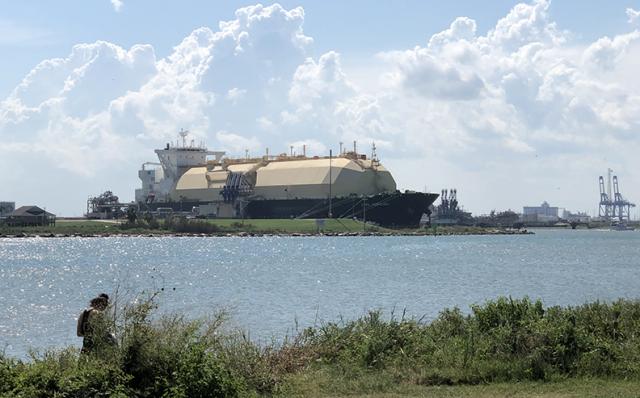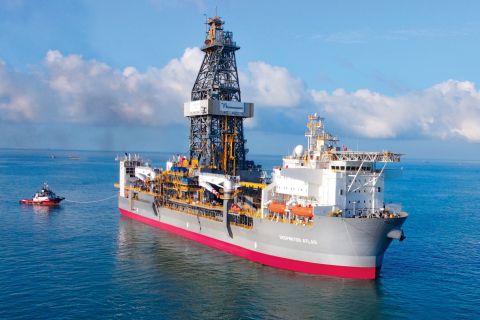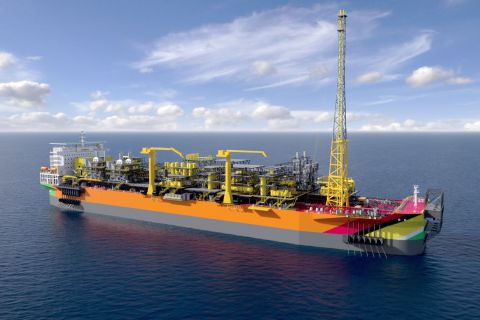
The LNG Jurojin prepares to depart Freeport LNG. (Source: Nissa Darbonne, Hart Energy)
LONDON—The commoditization of LNG is underway, and the oil and gas industry is preparing for how it will unfold and shape the market. LNG commoditization was one of the major themes discussed at the 40th Oil & Money conference, hosted by Energy Intelligence in London on Oct. 8-10, against the backdrop of a growing sense of urgency on how to tackle climate change concerns.
The consensus among keynote speakers and panelists, alike, was that natural gas is a major part of the solution to tackling climate change, rather than the problem. And within this, the evolution of the LNG trade will be a vital piece of the puzzle.
Speakers asked to comment on the commoditization of LNG were broadly in agreement that it was happening, but that the process still had some way to go.
“I think we’re in a transition period at the moment,” U.S. LNG developer Tellurian’s chairman, Charif Souki, told the conference. “We’re evolving from a point-to-point business model, which historically was underpinned by long-term contracts based on oil indexation, to a market that is becoming increasingly a commodity market but hasn’t quite gotten to that point yet.”
Souki predicted that the next five years would be a period of uncertainty in relation to how projects are financed and how this market is understood, with things moving quickly.
One of the main characteristics of an LNG commodity market is the considerable increase in flexibility from the way the fuel has been traded historically.
“The most important change we see is that the buyers tend to now be very comfortable with the fact that they will be able to buy LNG in the shorter-term market, in the spot market and in the longer-term market. They have options,” Höegh LNG’s president and CEO, Sveinung Støhle, said. “And that, for me at least, shows a much more liquid and dynamic market than what you saw only a few years ago.”
RELATED:
- Report: Grim Outlook For Natural Gas Prices
- Japan To Invest $10 Billion In Global LNG Infrastructure Projects
- LNG Investments Hit Record Of $50 Billion In 2019: IEA
The increased flexibility is also illustrated by more and more projects reaching the final investment decision (FID) stage without being fully backed by long-term offtake agreements. This is expected to play out across a number of markets. Santos’ managing director and CEO, Kevin Gallagher, said he expected his company—and Australia more broadly—to become a more niche seller of LNG from smaller brownfield projects in the future. Such projects can be equity-financed, meaning operators would not have the same constraints as they did previously with project financing underpinned by large, long-term contracts.
“That gives us a lot more flexibility in how we can market right across the Asian region,” Gallagher said.
Similar confidence in a new model was displayed by Tellurian’s senior vice president of LNG marketing, Tarek Souki. His company is proposing to build the Driftwood LNG project on the U.S. Gulf Coast, and Souki said he believed the cost model it is proposing to its investor group would put Tellurian in the top quartile of producers.
“I think these types of models are going to be the only way forward versus 20-year take-or-pay contract,” he said.
However, Venture Global LNG’s co-CEO and co-chairman, Michael Sabel, was among those saying that the majority of demand still came in the form of long-term contracts. He acknowledged, though, that more players can now afford blended portfolios of long- and short-term offerings.
Next Steps
The boom in exports out of the U.S. is seen as a catalyst for the commoditization of LNG, but other factors need to play a part too, including traders, liquidity and infrastructure, noted Energy Intelligence’s bureau chief for Singapore, Clara Tan. Indeed, the increasingly prominent role of major trading houses such as Trafigura, Vitol, and Gunvor in the LNG trade is further evidence of the commoditization process—and all three traders were represented on Oil & Money conference panels. Sabel described the entrance of the big trading houses as “positive additions” to the market, increasing the velocity of trading.
Speakers also noted that there was no clear global price for LNG, though certain options had emerged, including European gas benchmarks, the U.S. Henry Hub benchmark and the Platts Japan/Korea Marker (JKM) as trading shifted away from oil-indexation.
“We’ve definitely come a long way from when it was just pure oil-linked contracts,” Total Mozambique LNG’s vice president of LNG marketing and shipping, Andrew Seck, said. “If you look at the diversity that now exists within pricing, it’s immense, but we’re not there at a single globalized commodity price today.” He believes pricing is still regional, but that the regions are increasingly being linked.
Others echoed similar views, with Royal Dutch Shell Plc’s executive vice president of integrated gas ventures, De La Rey Venter, saying he did not believe there will ever be a global LNG price for the same reason there is no global natural gas price. Different prices are still being driven by regional trends, he noted, but added that he expected short-term indices globally to converge as commoditization plays out.
JKM, meanwhile, was described as representing some flexibility and some of the market, but still being too illiquid for those wanting to hedge. However, speakers agreed that JKM has potential to evolve, and suggested that eventually – in perhaps 6-7 years—LNG could be traded on a forward curve, but that the market was not there yet.
The key difference between LNG and other hard commodities, Venter said, was that given the difficulty of storing LNG, large inventories cannot be built up. “Therefore your spot price will forever be particularly sensitive to periods of market tightness, or the market being sufficiently well-supplied,” he added. The industry is moving to add more floating storage capacity globally, but this vulnerability makes it all the more important for LNG exporters to keep a lid on costs.
Part Of The Solution
The role of natural gas more broadly—not just LNG alone—was repeatedly talked up as a key part of the energy transition at the Oil & Money conference. The comments come as the energy industry tries to show that it is balancing its emissions reduction efforts with meeting growing demand, particularly in Asia.
“Climate change is the defining topic of this generation,” Novatek’s CFO and deputy chairman of the management board, Mark Gyetvay, said. “Gas is only one solution, but it is an important solution, because without gas we would have not seen part of the transition we have already made.”
Iberdrola’s senior vice president of global gas, José Simón Buela, meanwhile suggested that the real competitor for natural gas in power generation was not renewable energy, but rather coal. However, LNG’s role goes beyond supplying utilities, with it also being talked up as a bunker fuel for the shipping industry as it moves to limit the sulfur content in marine fuel.
Sustainability and climate change goals featured prominently in discussions. This will almost certainly not be enough to appease the environmental protesters that targeted the conference, demanding an end to the production of all fossil fuels, but the tone of discussions showed that the issue is being taken increasingly seriously.
Recommended Reading
Petrobras to Step Up Exploration with $7.5B in Capex, CEO Says
2024-03-26 - Petrobras CEO Jean Paul Prates said the company is considering exploration opportunities from the Equatorial margin of South America to West Africa.
Deepwater Roundup 2024: Offshore Australasia, Surrounding Areas
2024-04-09 - Projects in Australia and Asia are progressing in part two of Hart Energy's 2024 Deepwater Roundup. Deepwater projects in Vietnam and Australia look to yield high reserves, while a project offshore Malaysia looks to will be developed by an solar panel powered FPSO.
Rystad: More Deepwater Wells to be Drilled in 2024
2024-02-29 - Upstream majors dive into deeper and frontier waters while exploration budgets for 2024 remain flat.
E&P Highlights: April 1, 2024
2024-04-01 - Here’s a roundup of the latest E&P headlines, including new contract awards.
Pitts: Heavyweight Battle Brewing Between US Supermajors in South America
2024-04-09 - Exxon Mobil took the first swing in defense of its right of first refusal for Hess' interest in Guyana's Stabroek Block, but Chevron isn't backing down.






